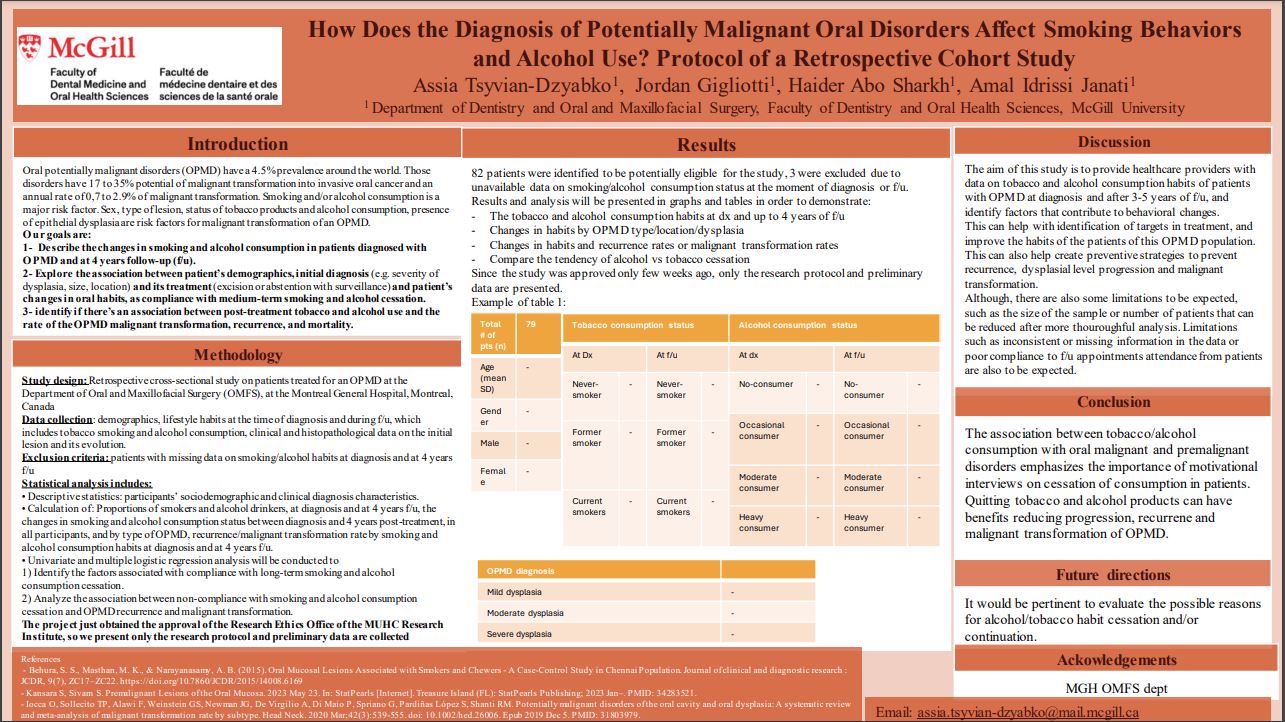How Does the Diagnosis of Potentially Malignant Oral Disorder Affect Smoking Behaviors and Alcohol Use? Protocol of a Retrospective Cohort Study
Authors : Assia Tsyvian1, Haider Abo Sharkh1, Jordan Gigliotti1, Amal Idrissi Janati1
Affiliation: Faculty of Dental Medicine and Oral Health Sciences, McGill University
Background: Oral potentially malignant disorders (OPMD) have a 4.5% prevalence around the world, with men being more affected than women. Those disorders have 17 to 35% potential of malignant transformation into invasive oral cancer, with an average annual rate of 0,7 to 2.9% of malignant transformation. Smoking alone or in combination with alcohol consumption is a major risk factor for oral cancerous and precancerous lesions. It was shown that sex, type of lesion, status of tobacco products and alcohol consumption, as well as presence of epithelial dysplasia are risk factors for malignant transformation of an OPMD. Other studies have demonstrated that cessation of tobacco and alcohol consumption have beneficial effect on the long-term prognosis of cancerous lesions. However, very few data is available on patient’s medium and long-term compliance to tobacco and alcohol cessation, following a diagnosis of OPMD, as well as on the factors that might affect tobacco and alcohol consumption in these patients. Therefore, the main goal of our project is to describe the changes in smoking and alcohol consumption in patients diagnosed with OPMD, between diagnosis and 4 years follow-up. The second goal is to explore the association between patient’ demographics, initial diagnosis (e.g. severity of dysplasia, size, location) and its treatment (excision or abstention with surveillance) and patient’s changes in oral habits, as compliance with medium-term smoking and alcohol cessation. Our third objective is to identify if there’s an association between post-treatment tobacco and alcohol use and the rate of the OPMD malignant transformation, recurrence, and mortality.
Methods: We’ll conduct a primary analysis of real-word data from a retrospective cohort of patients who were diagnosed of OPMD at McGill University Health Centre (MUHC) Oral and Maxillofacial Surgery (OFMS) department between 2018-2019 and who have been followed-up by the end of 2023. Patients’ health care records will be reviewed to collect data on age, sex, comorbidities, OPMD type, site, histopathological type, and recurrence, smoking and alcohol consumption behaviors at diagnosis and at 4 years follow-up. Statistical analysis will include: 1) Descriptive statistics of participants’ sociodemographic and clinical diagnosis characteristics; 2) McNemar's test to compare the proportions of smokers and of moderate-to-heavy drinkers between the time of diagnosis and 4 years later; 3)Wilcoxon signed-rank test to compare packs-years and alcohol beverages between both timelines. Also, we will conduct univariate and multivariate logistic regression analysis to analyze the association between both smoking and moderate-to-heavy drinking cessation and: i) factors, as age, sex, clinical and histological characteristics of the OPMD at diagnosis, and treatment received; ii) recurrence/progression of the OPMD. The project is under review by the Research Ethics Board of the MUHC Research Institute.
Results: About 100 patients with OPMD were referred for to the MUHC OMFS department during the study period. Preliminary results will be presented.
Discussion: Our study goal is to provide healthcare providers with data on smoking and alcohol consumption behaviors of OPMD patients over the medium term and identify factors related to changes in these health behaviors. This can then help in identifying treatment targets and improve habits for this population of OPMD patients. Furthermore, it will help improve strategies to prevent malignant transformation.
